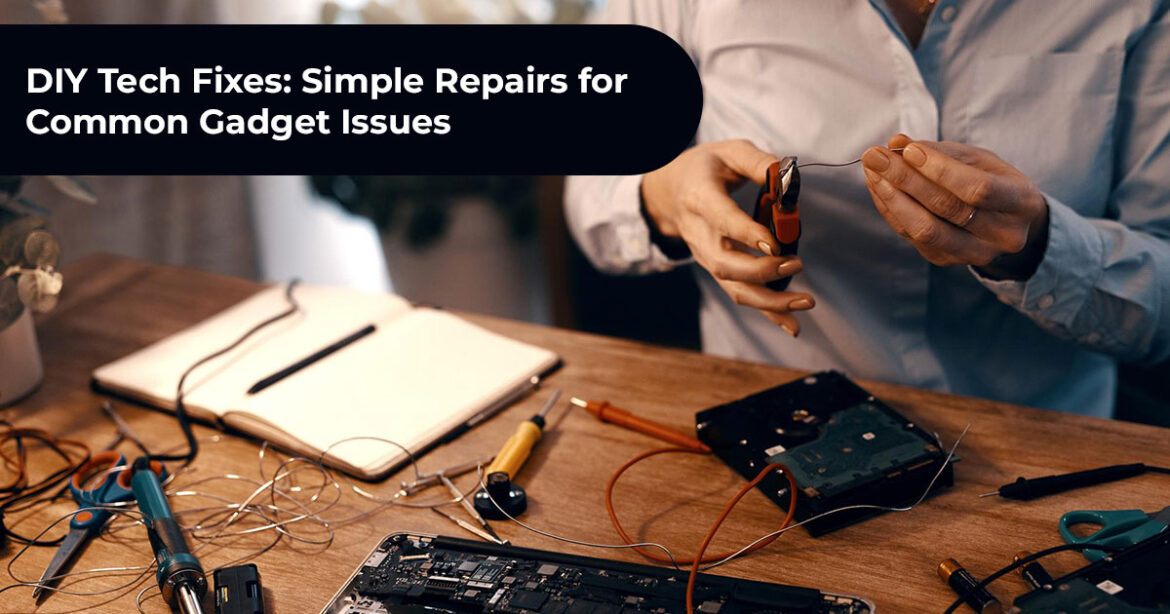In today’s fast-paced digital world, gadgets have become essential companions. From smartphones and tablets to laptops and other smart devices, they support both work and leisure. However, frequent use often leads to minor malfunctions. While professional repair services can help, many issues can be solved at home. This is where DIY tech fixes come in practical, cost-effective methods that help users troubleshoot and repair their devices without technical expertise.
This article explores several common gadget issues and provides easy DIY tech fixes for problems like smartphone slow performance, tablet battery drain, unresponsive touchscreen, laptop slow boot, laptop overheating, charging issues, and connectivity problems. By understanding these fixes, anyone can improve gadget performance and extend device life.
1. Understanding the Concept of DIY Tech Fixes
DIY tech fixes refer to do-it-yourself repair techniques for addressing small hardware or software problems. These solutions typically involve cleaning components, adjusting settings, installing updates, or replacing minor parts.
The purpose of DIY tech fixes is not just to save money but also to promote sustainability by reducing electronic waste. Instead of discarding devices over simple malfunctions, users can make small, informed repairs that restore performance and longevity.
2. Smartphone Slow Performance: Causes and Solutions
One of the most common gadget issues users face is smartphone slow performance. Over time, phones can become sluggish due to excess background apps, insufficient storage, or outdated software.
Here are some effective DIY tech fixes for this problem:
- Clear Cache and Temporary Files: Cached data accumulates over time and slows the device. Regularly clearing it can free storage and improve speed.
- Update Software: System updates often include bug fixes and optimizations that enhance performance.
- Manage Applications: Uninstall or disable unused apps that consume memory in the background.
- Restart Regularly: A simple reboot clears temporary memory and refreshes processes.
By following these DIY tech fixes, users can easily overcome smartphone slow performance and enjoy smoother operation.
3. Tablet Battery Drain and How to Fix It
Another frustrating issue is tablet battery drain. Continuous app use, high brightness, and background syncing often cause power loss. Luckily, some straightforward DIY tech fixes can significantly extend battery life.
- Adjust Screen Brightness: Lowering brightness or enabling auto-brightness conserves battery.
- Limit Background Activities: Turn off background data or auto-sync for unused apps.
- Activate Battery Saver Mode: Most tablets include built-in settings to extend battery performance.
- Replace the Battery (if needed): If the tablet is older, the battery may no longer hold a full charge. Replacing it can restore longevity.
Implementing these DIY tech fixes helps solve tablet battery drain problems effectively and ensures longer daily usage.
4. Fixing an Unresponsive Touchscreen
An unresponsive touchscreen can interrupt daily tasks, but many causes are easily fixable. Instead of panicking, users can try a few DIY tech fixes before seeking repairs.
- Clean the Screen: Fingerprints, dirt, and oil can affect touch sensitivity. Use a microfiber cloth to clean gently.
- Restart the Device: A simple restart can reset system errors that cause touch problems.
- Remove Screen Protector: Some protectors reduce touch sensitivity; removing or replacing them might help.
- Install Software Updates: Updates can fix touchscreen calibration bugs.
- Factory Reset (if necessary): As a last resort, resetting can fix persistent software issues.
By following these steps, an unresponsive touchscreen can often be restored without professional help.
5. Laptop Slow Boot: How to Speed It Up
A laptop slow boot can be incredibly frustrating, especially when time is limited. Fortunately, several DIY tech fixes can dramatically improve startup speed.
- Disable Startup Programs: Too many auto-start apps slow booting. Disable unnecessary ones.
- Upgrade to SSD: Switching from an HDD to an SSD reduces boot time and enhances performance.
- Clean Disk Storage: Remove unwanted files and programs to free up space.
- Run a Virus Scan: Malware often slows systems during startup.
- Update the Operating System: Updates can improve boot efficiency and fix software glitches.
With these DIY tech fixes, users can solve laptop slow boot problems and improve overall system performance.
6. Managing Laptop Overheating
Another of the common gadget issues users face is laptop overheating. Excess heat can lead to reduced performance and even hardware damage. Luckily, there are practical DIY tech fixes that help maintain an optimal temperature.
- Clean the Fans and Vents: Dust accumulation restricts airflow. Use compressed air to clean vents.
- Use a Cooling Pad: Elevating the laptop enhances airflow and prevents overheating.
- Close Heavy Programs: Reduce CPU load by shutting down intensive applications.
- Reapply Thermal Paste: For advanced users, reapplying thermal paste can significantly improve cooling.
These DIY tech fixes are essential for preventing laptop overheating and ensuring long-term device health.
7. Fixing Charging Issues
Charging issues are among the most frequent common gadget issues. When a device charges slowly or doesn’t charge at all, the cause is often simple.
Try the following DIY tech fixes:
- Check the Cable and Adapter: Damaged cords or incompatible adapters cause charging failure.
- Clean the Charging Port: Dust or debris can block the connection. Clean gently with compressed air.
- Restart or Reset the Device: Software glitches can sometimes interfere with charging.
- Use a Different Power Source: The outlet or USB port may be faulty.
- Inspect Battery Health: Batteries lose efficiency over time; consider a replacement if it drains quickly.
With these steps, most charging issues can be resolved at home.
8. Solving Connectivity Problems
From Wi-Fi disconnections to Bluetooth pairing failures, connectivity problems are common but usually easy to fix. Here are some reliable DIY tech fixes to restore stable connections:
- Restart the Device and Router: A simple restart often clears temporary network errors.
- Forget and Reconnect Networks: Reconnecting can refresh wireless connections.
- Update Network Drivers: Outdated firmware or drivers can cause instability.
- Toggle Airplane Mode: Turning it on and off resets wireless connections.
- Reset Network Settings: As a last option, this restores factory network configurations.
Applying these DIY tech fixes can effectively solve connectivity problems without needing advanced technical skills.
9. Preventive Device Maintenance Tips
Prevention is key to reducing common gadget issues. Following proper device maintenance tips ensures better performance and longer lifespan.
- Keep Devices Clean: Regular cleaning prevents dust buildup and internal damage.
- Update Software Frequently: Updates improve performance and fix bugs.
- Avoid Overcharging: Prolonged charging shortens battery life.
- Use Protective Cases: Protects devices from physical damage.
- Store in Safe Conditions: Avoid heat and moisture to prevent internal corrosion.
Practicing these device maintenance tips helps reduce the likelihood of future malfunctions and supports consistent performance.
Conclusion
Minor gadget malfunctions are inevitable in today’s technology-driven world. However, by applying DIY tech fixes, users can address issues like smartphone slow performance, tablet battery drain, unresponsive touchscreen, laptop slow boot, laptop overheating, charging issues, and connectivity problems without spending on costly repairs.
Understanding how to apply these DIY tech fixes and following regular device maintenance tips not only saves money but also supports sustainability by reducing electronic waste. Instead of replacing a device at the first sign of trouble, taking time to troubleshoot empowers users to handle issues confidently.
Ultimately, DIY tech fixes encourage self-reliance, environmental awareness, and a smarter approach to technology care making everyday gadgets last longer and perform better.

